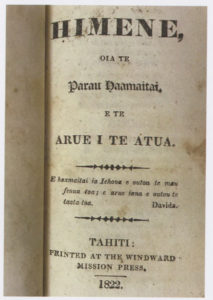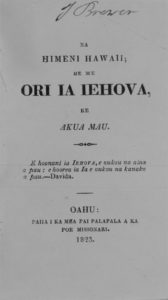The work of spreading Christianity got an unexpected boost when Rev. William Ellis landed in Hawai‘i in the spring of 1822, travelling from Tahiti en route to the Marquesas. Ellis, an English missionary and skilled linguist, had been living in the Society Islands since 1816 and helped translate the oral Tahitian language into written form. His fluency allowed him to quickly master the Hawaiian language, which is similar to Tahitian,1 and to preach and compose hymns in Hawaiian, bridging the communication barriers that still existed.2 The Hawaiian mission was also presented with two small hymnals in Tahitian which had enhanced mission work in the Society Islands. When Ellis returned to Honolulu with his family in 1823, he brought a Tahitian teacher and Christian convert, whom Queen Keōpūolani selected as her principal instructor.

“We have found a very valuable assistant in Mr. Ellis, the missionary from Huohine, in our attempts at the language; while from the great similarity between the Taheiton language and this, he was able in a very few weeks to address the people in public, in their own tongue.”
— Sybil Bingham’s Journal, August 9, 1822

— Kam, Ralph Thomas, “The Origins and Legacy of Na Himeni Hawaii,” p. 91.
— Samuel L. Kamakau, Ruling Chiefs of Hawaii (Revised Edition), p. 254
2 Rod Edmond, “Translating Cultures,” in Science and Exploration in the Pacific (UK: Boydell & Brewer, 1998), p. 153.
